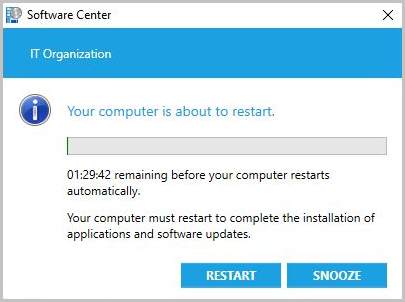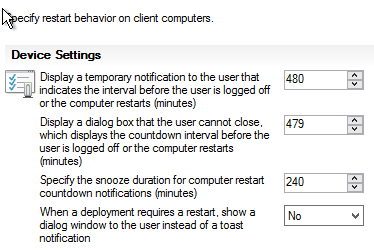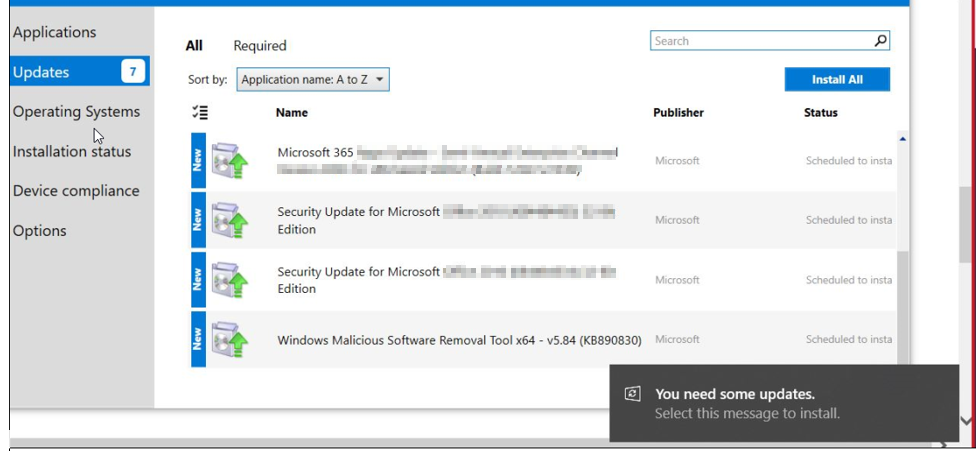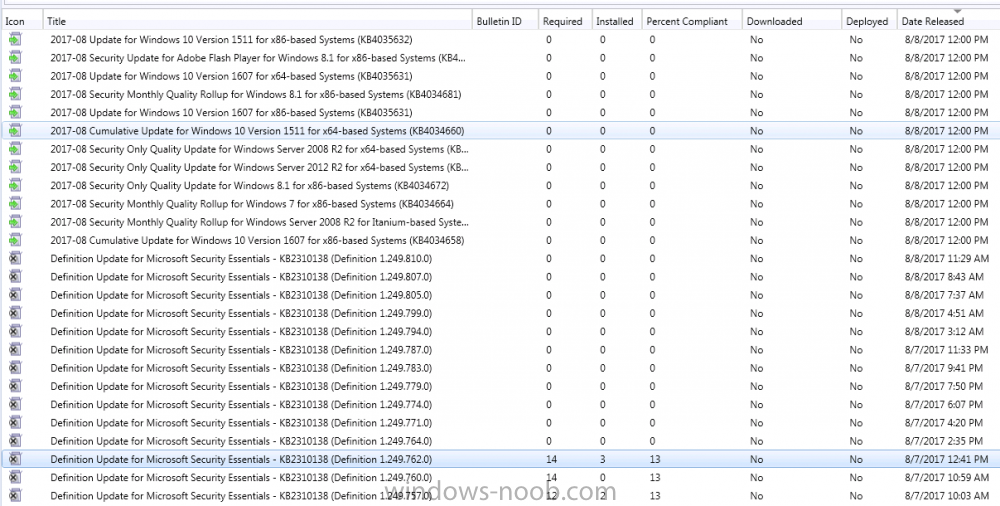
BryanP
Established Members-
Posts
36 -
Joined
-
Last visited
-
Days Won
3
Everything posted by BryanP
-
My windows update deployments are set with User Experience/User Notifications set to "Display in Software Center, and only show notifications for computer restarts." Some (but not all?) of my users are reporting that they're getting a non-SCCM Windows notification. When the installation takes place they get the regular notification from SCCM that they will be rebooted in X minutes, which is all I want. I don't want them to get the regular Windows notification. Am I missing something obvious? How do I suppress these?
-
I know you can see what applications are using how much data in a given period of time by going to Start -> Settings -> Network & Internet -> Data Usage, then clicking the Usage Details option to bring up a list. Does anyone know if there's a way to output this list at the command line or from powershell? If there is a way I haven't been able to find it.
-
I've got an install of Office 365 set up in SCCM that will uninstall Office 2010 and then install Office 365 (local copies of Outlook/Excel/Word etc.. 2016) Maybe my google skills are weak, but I'm trying to figure out how to migrate local settings in Outlook. The main thing is people who have a local .pst archive configured. In theory they're not supposed to be doing that, but I'm still not allowed to break it. Is there a way to export account settings from Outlook 2010, including the location of the .pst archive, then import that in to Outlook 2016? Preferably something I can automate as part of the uninistall/reinstall I push from SCCM. I've found pages that talk about moving account settings from one install of the same version to another install of the same version on a new machine by exporting and importing the appropriate registry keys, but that doesn't seem to be very helpful here.
-
Creating Post Script
BryanP replied to Elad's topic in System Center Configuration Manager (Current Branch)
As someone else already mentioned, if you're running a script to perform the installation, just append it to the end of your script. If you were deploying it as an SCCM Package (instead of an Application), then you could create two packages. Have Package A install OneNote. Have Package B run your command. Then use the Run another program first option on Package B, tell it that it has to install Package A, then deploy Package B. I'm sure there's an equivalent to that with Applications, but in all honesty I still do far more with packages than applications. -
SCCM 1706 Console Installer Files?
BryanP replied to BryanP's topic in System Center Configuration Manager (Current Branch)
... aaand I should learn to try things first. The install file for that console you pointed me to is 5.0.8540.1003, but it installs as .1600. *sigh* Thanks again. -
SCCM 1706 Console Installer Files?
BryanP replied to BryanP's topic in System Center Configuration Manager (Current Branch)
Thank you, that helps a lot. I had found that one, but passed it over because the version # - 5.0.8540.1003 - was lower than the version updated to by the console, 5.0.8540.1600. Now I'm off to try and find the .msp that takes it up to .1600. Thanks again. -
Does anyone know where the installation files for the SCCM Console for 1706 are located? One of my coworkers updated us from 1610 to 1706 this past weekend. The automatic update when you start the console works fine, but I need to be able to deploy it as an application. I was able to get it out of 1610, but I am unable to locate it in 1706. I found what appeared to be it under \SMSPKGSIG\xxxxxxxx\SMSSETUP\BIN\I386, but when I attempt to run the consolesetup.exe from that folder, it tells me it isn't compatible with 64-bit versions of Windows. Am I missing something obvious?
-
I've got a lot more home based users coming in over VPN these days. Our VPN group wants to make sure that anyone connecting has all their updates. The problem is, our environment is ... slow. For users in the office it's not a problem. Updates are downloading in the background, they install when they're done. For people having their update compliance checked in the VPN client, this is a problem as they can't work until updates download and install. I could set up internet based client management by putting an MP/DP in the DMZ, but the networking group would rather the users disconnect and get their updates from Microsoft if possible rather than use our bandwidth. After reading this is page I was thinking about turning his problem into my solution, but I'm wondering if anyone else here has tried it? https://sccmcanuck.wordpress.com/2017/05/25/sccm-software-updates-a-lesson-in-humility/ If I'm reading this correctly, I should be able to do the following: Create a collection of the machines that need to pass the compliance check. Exclude that collection from my regular update deployment. Create a separate update deployment to them with the option checked for "If software updates are not available on distribution point in current, neighbor, or site boundary groups, download content from Microsoft Updates." Have the networking people set their VPN compliance check so that it disconnects them from the VPN if they aren't compliant. If I'm understanding the setting correctly, the client should go straight to Microsoft and download updates, even though it doesn't have access to a management point? Is that correct? Yes, I could just set it up and test it, but I'm hoping someone else has already gone through this. If
-
So this month I'm still seeing new updates as not required by clients, when I know they are. I've eliminated what I thought was causing it last time (we had problems with the anti virus client on the main site server monopolizing processor time). Right now I'm manually downloading the updates I know I will need and adding them to the deployment package. Based on last month, I expect the required and installed fields for 9/12 to populate sometime tonight. Does anyone know if it's normal to have a 24-36 hour delay between the updates showing up in the catalog under All Software Updates and the Required field populating?
-
1612? Looking that one up: "Error 1612: Installation source for this product is not available" You could try dropping the Adobe cleaner in with your install and have it run this command before kicking off the installation: AdbeArCleaner_v2.exe /silent /product=1 Product=1 means Adobe Reader, so it won't touch any Adobe Acrobat installs. The downside to this is that if the cleaner successfully runs and the reader install fails, you've just removed the old version and you haven't installed a new one.
-
Still trying to figure out what's going on. They finally populated sometime after 8PM last night. I know because I have a second test ADR scheduled to run on Wednesday at 8PM, and none of the new updates have been marked as downloaded or deployed. *sigh* Time to dig deeper, but at least I can begin testing updates now. I have a suspicion as to what the problem is, but I'll have to argue with someone who controls settings I don't manage. *sigh*
-
For several years now I've had a simple Patch Tuesday routine. At 2PM on Patch Tuesday my SUP syncs to get the new catalog, then at 8PM an ADR runs to deploy to my test boxes. I'd come in the next morning, and if nothing went wrong they would have rebooted and be ready for initial testing. Earlier this month when Microsoft released the fix for the Outlook 2010 problems created in June, I noticed that when it came in that I had very few machines saying they required it, when I expected over 20,000. I downloaded the patch for manual testing in the meantime, and the next time I went back to check, Required had populated as expected. So yesterday was Patch Tuesday. None of my test boxes rebooted. So I looked, and I'm seeing Required populated up through 8/7/2017 at 12:41PM, and nothing past that. Based on that I'm expecting things to populate mid day today, which I will be watching for, but does anybody have an idea why this delay would begin happening when I've never seen it before this month?
-
Do you have software inventory set to inventory .dll files and to not exclude c:\windows? If so, then the collection would look like this: select SMS_R_System.ResourceId, SMS_R_System.ResourceType, SMS_R_System.Name, SMS_R_System.SMSUniqueIdentifier, SMS_R_System.ResourceDomainORWorkgroup, SMS_R_System.Client from SMS_R_System inner join SMS_G_System_SoftwareFile on SMS_G_System_SoftwareFile.ResourceID = SMS_R_System.ResourceId where SMS_G_System_SoftwareFile.FilePath = "C:\\Windows\\System\\" and SMS_G_System_SoftwareFile.FileName = "nlwnsck.dll" If inventory is set correctly and the collection still doesn't populate, try this instead: select SMS_R_System.ResourceId, SMS_R_System.ResourceType, SMS_R_System.Name, SMS_R_System.SMSUniqueIdentifier, SMS_R_System.ResourceDomainORWorkgroup, SMS_R_System.Client from SMS_R_System inner join SMS_G_System_SoftwareFile on SMS_G_System_SoftwareFile.ResourceID = SMS_R_System.ResourceId where SMS_G_System_SoftwareFile.FilePath like "%C:\\Windows\\System\\%" and SMS_G_System_SoftwareFile.FileName = "nlwnsck.dll"
-
I'm still getting the same error, but at least now I know it's probably something I'm doing wrong. I haven't had time to look at this, it's been kind crazy here (except that crazy is normal). I'm about to be gone for a week, and at least for the moment the urgency on this has dropped. I'll work on it some more when I get back and hopefully I can figure it out. Thanks for the help.
-
Sorry it took so long to get back to this. I had several things come up that pushed this way down my list of priorities at work for the last week or so. I've gone through the entire process again today and I'm getting the same results. I've attached these files: configuration.mof - this is the untouched configuration.mof file in my inboxes\clifiles.src\hinv folder. RegKeyToMof_WinLogon.txt - This contains the output of the configuration.mof tab of RegKeyToMof after I selected SOFTWARE\Microsoft\Windows NT\CurrentVersion\WinLogon, and changed the Group label to Custom_Registry. RCM.mof - this contains the output from the to import in Admin/AgentSettings/HardwareInventory/SetClasses/Import tab appended_configuration.mof - this is the configuration.mof file listed above with the content of RegKeyToMof_WinLogon.txt appended, in case you need to make sure I didn't screw that up. Any help is appreciated. Including "Oh, you might want to click that first ya idjit." appended_configuration.mof configuration.mof RCM.mof RegKeyToMof_WinLogon.txt
-
Thank you. I'll get that as soon as I can.
-
I've been trying to follow those instructions, but when I get to the final step I get an error about "No valid classes or settings were found to import from the MOF file." I've gone back through the instructions to make sure I was following them exactly, not missing any characters on the copy & paste, etc, but I get the same results. Any suggestions?
-
I'm trying to run a script against my computers with SCCM. It's a very simple powershell script (it has to be, I'm not much of a scripter), and it works perfectly from the command line. However, when I try to deploy it from SCCM it fails every time. I've tried writing directly to the share, I've tried mapping a drive, I've tried deploying it with admin rights and using the logged in user's rights. I'm hoping someone here can tell me what I'm doing wrong. The script is below. I know it works, but I don't know why I can't deploy it. # Write the value of the AutoAdminLogon key to $val $val = Get-ItemProperty -Path "hklm:\SOFTWARE\Microsoft\Windows NT\CurrentVersion\Winlogon" -Name "AutoAdminLogon" # If the AutoAdminLogon key information exists and it is anything other than 0 # write that information to a file on a network share. # File will be <computername>.txt if($val) { if($val.AutoAdminLogon -ne 0) { $val | Out-File \\<sharelocation>\AutoAdminLogonLog\$env:COMPUTERNAME.txt" } }
-
SCCM 2012 R2 SP1 and Windows 10 Upgrades Classification
BryanP replied to BryanP's topic in Configuration Manager 2012
Hopefully I'll be able to talk to someone at MS soon and get an answer for this. When I do I'll post it here.






